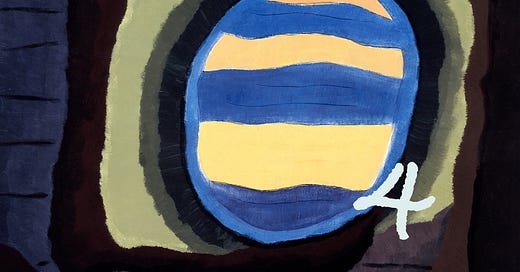Conjure the nouns, alert the secret self, taste the darkness … speak softly, and write any old word that wants to jump out of your nerves onto the page. ~Ray Bradbury
Creative Prompt #4: Finding Order in Chaos—The Art of Listing | 30-Day Creativity Challenge
Arthur Dove's Out the Window (1939) famous painting. Original from the Saint Louis Art Museum.
Friends, I hope you found yourself slightly more alive and attuned over the course of the day yesterday as you listened more deeply, more actively, and more intuitively hour by hour. Maybe the effort was fruitful and at least a little bit transformative. Or maybe it was frustrating and tiring (in which case, of course, we might turn our attention back to Maria Popova’s post, The Importance of Frustration in the Creative Process, in which she writes about Jonah Lehrer’s book, Imagine: How Creativity Works and its trailer).
Maybe you experienced both transformation and frustration, and maybe those forces softened you or surprised you or heightened your senses. I hope you take some of that kind of listening forward into the rest of our 30-Day Creativity Challenge.
And as we enter our fourth day, I wonder, if in that heightened listening energy, you might have begun to notice that making lists—or, “listing” as I like to call it—is a frequently included step in these creativity prompts.
There is a very good reason for that. The art of listing is well known to boost creativity. Many of our greatest creative minds have extolled the power of lists for creative engagement, including Ray Bradbury who, in the book Zen in the Art of Writing, revealed his habit, from his early twenties, of writing long lists of nouns to both generate ideas and serve as possible story titles. Bradbury said:
These lists were the provocations, finally, that caused my better stuff to surface. I was feeling my way toward something honest, hidden under the trapdoor on the top of my skull.
The lists ran something like this:
THE LAKE. THE NIGHT. THE CRICKETS. THE RAVINE. THE ATTIC. THE BASEMENT. THE TRAPDOOR. THE BABY. THE CROWD. THE NIGHT TRAIN. THE FOG HORN. THE SCYTHE. THE CARNIVAL. THE CAROUSEL. THE DWARF. THE MIRROR MAZE. THE SKELETON.
I was beginning to see a pattern in the list, in these words that I had simply flung forth on paper, trusting my subconscious to give bread, as it were, to the birds. Glancing over the list, I discovered my old love and fright having to do with circuses and carnivals. I remembered, and then forgot, and then remembered again, how terrified I had been when my mother took me for my first ride on a merry-go-round. With the calliope screaming and the world spinning and the terrible horses leaping, I added my shrieks to the din. I did not go near the carousel again for years. When I really did, decades later, it rode me into the midst of Something Wicked This Way Comes.
More recently, contemporary fiction writer Yelizaveta P. Renfro told Glimmer Train (remember Glimmer Train? I miss that journal!) that her stories and essays often begin with lists:
On whatever is at hand—and often in the margins or endpapers of books I’m reading—I jot down fragments in the order that my mind offers them. This first step is a purging of these pieces, without structure. It’s notating in shorthand what will go in the container, whether the container is an essay or a story.
And, writing for the Brevity Blog in 2021, nonfiction writer Jill Kolongowksi said that while the pandemic robbed her temporarily of her ability to write things with beginnings, middles, and endings, listing remained available:
With a list, I could put a small bit of sense in the senseless. Do this, then do that. Sometimes, there was no “then,” either. Just a list—one thing, another, ways to shape the day, a container of some form of order, when every moment felt beyond unpredictable. In between feeding the baby every two hours, I made small lists. Put away laundry. Read one article. Shave armpits. Read one chapter. Thaw chicken. Write a paragraph. I sometimes crossed things off, and sometimes crossing things off felt like it took too long, but the list was a concrete object narrative I needed.
My [creative] writing started to take the same form.
As you have surely guessed by now, we’re going to play with lists today—exploring a handful of concrete, guided ways through which lists can engender mystery and magic, reveal interesting portals, bring you across potent thresholds, and potentially reveal you to yourself, as Ray Bradbury described:
If you are a writer, or hope to be one, similar lists, dredged out of the lopside of your brain, might well help you discover you, even as I flopped around and finally found me.
So, let’s get started on some unusual, generative listing. I’ll provide you the specific, granular instruction to propel you toward some unfamiliar terrain. And I look forward to hearing all about it!





